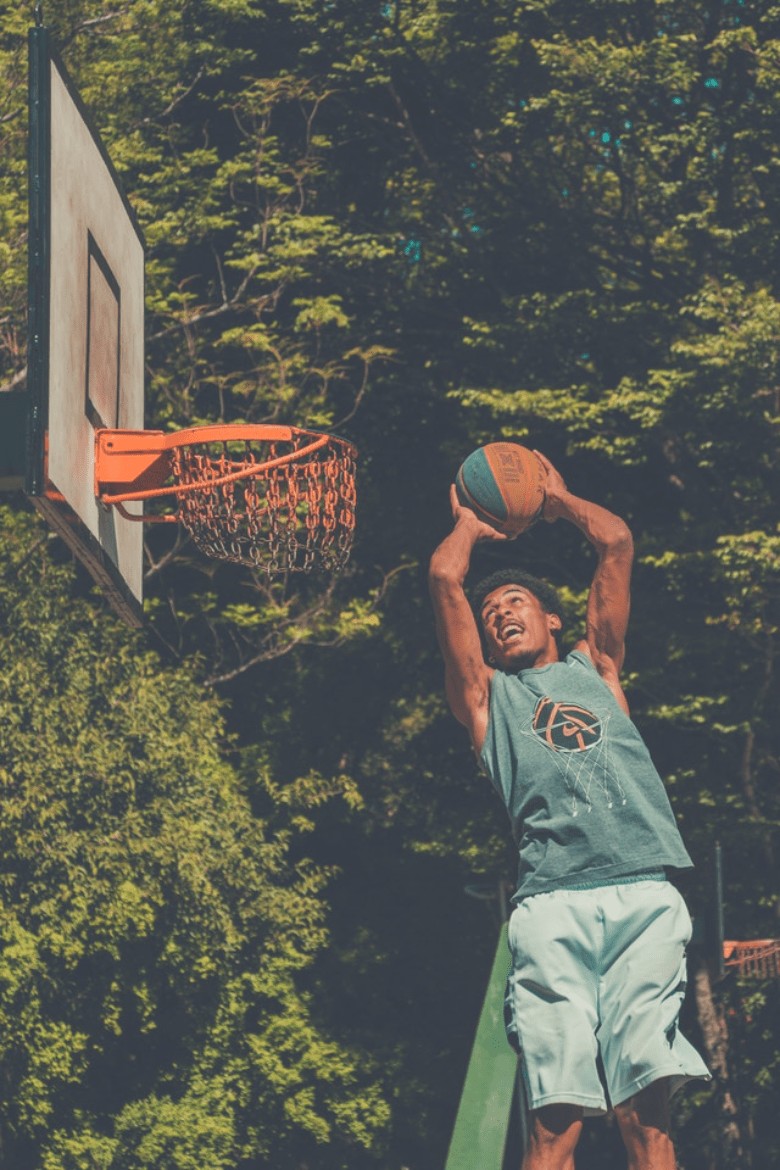You may have dreamed of flying through the air like your all-time favorites like Lebron James or Michael Jordan.
But your dream becomes short-lived when you don’t know how to dunk or fall short at the basket.
However, you improve your vertical jump and make a basket shot each time.
How?
We hold the science and secrets on how to dunk perfectly, every time.
Why You Want to Increase Your Vertical Jump?
There are a few reasons why you might want to improve your vertical jump. Some people want to showcase their jump height.
Others may want to impress their coach or scouter. But some just might want to learn how to dunk with a high jump.
Whatever your reason is for wanting to have a higher vertical jump, there are ways to help you achieve it.
Science Behind the Vertical Jump
Vertical jumps can be broken down into a science.
Physics to be exact.
How?
Well, let’s start with the formula for a vertical jump. It begins with power, strength, and velocity.
In physics, power equals force times velocity. When you practice a vertical jump, the force is the strength someone has.
Velocity
Velocity stands for the speed someone has. If you increase both your strength and velocity, your jump can improve.
Your strength is measured by how well you perform at certain exercises.
Some of these exercises like the Olympic back squats, box squats, deadlifts, and front squats will give your measurement.
These exercises are effective for the vertical jump. When you increase the weight during these types of exercises, your vertical jump increases.
The velocity stands for the speed at which your vertical jump is done. The vertical jump is a quick movement.
They typically happen within .2 seconds. Quicker velocity will let you show your real strength.
Your velocity can increase by performing exercises like shock jumps, depth jumps, or even just regular jumping.

Let’s go over an example to see how the formula works. Take two athletes named Bob and Jim. Bob weighs 160lbs, squats at 300lbs, and has a power of 250lbs in the vertical jump.
Jim weighs 160lbs, squats at 300lbs, and has a power of 100lbs in the vertical jump. Now, both Bob and Jim weigh and squat the same.
But their vertical jumps differ with Bob exerting more force than Jim.
Therefore, Bob can jump higher than Jim. Jim will have to increase his velocity to exert more power over the vertical jump.
Let’s take another example where both athletes squat the same and have the same power but differ in weight.
One athlete weighs 160lbs but the other weighs 300lbs. The athlete that weighs less will have a better power-to-weight ratio and a higher vertical jump than the athlete that weighs more.
The heavier athlete will have to lose some weight to get a higher vertical jump.
We looked at examples where athletes are relatively the same in everything but one thing. But what if they differ in everything but their weight?
Both athletes weigh 160lbs, but their squat weight and power in vertical jumps are different. One athlete squats at 160lbs and has a power output of 155lbs.
The other has a squat maximum of 400lbs and a power output of 375lbs for the vertical jump. Which athlete jumps higher?
The second athlete has a higher vertical jump than the first.
Why?
The second athlete has a better power output because he has a stronger power and maximum squat.
You don’t just want to focus on the formula though. There are other factors you should consider that will help you with your vertical jump.
Flexibility
Flexibility seems useless when you’re just jumping but it actually helps your body and improves your vertical jump.
If you lack flexibility, you won’t be able to properly position your body and achieve a full range of motion when you jump.
Unfortunately, a lack of flexibility limits your vertical jump. Stretching can help increase your flexibility and helps with injury prevention.

Stretches
There are two types of stretches called dynamic stretches and static stretches. Dynamic stretches are typically performed before a workout to warm up your muscles.
Dynamic Stretching
Dynamic stretches use momentum and speeds of movements to stretch the muscle. For example, you can swing your legs side to side, arm circles, or trunk twists.
Dynamic stretches tend to mimic the movement of the activity you’re about to perform.
Static Stretching
Static stretches are performed at the end of a workout and requires you to hold the stretch for some time.
This allows your muscles to loosen up while increasing your range of motion and flexibility. There are added benefits to static stretches.
It helps with pain and stiffness after a workout since you can sometimes have tight or overworked muscles.
Static stretching improves circulation which helps muscles recover faster after a workout. Believe it or not, static stretches can improve your performance.
How?
You increase your flexibility which enhances your agility, speed, and muscle strength.
The next time you work out, your next activity may be easier for you and you’ll perform better.
Some examples of static stretches are the cobra pose, overhead triceps stretch, and head-to-knee forward bend.
Best Exercises to Improve Your Vertical Jump
Now, it may seem like a lot of work just to improve your vertical jump but it’s not as complicated as it looks.
There are many exercises you can perform or programs you can follow that will help you improve your vertical jump.
You can add these exercises to your current routine or just focus more on exercises like this.
If you want to increase your vertical jump and learn how to dunk like the pros, incorporate these into your routine.
Trap Bar Deadlift
The trap bar deadlift is one exercise that will help with your strength to jump high. Like with our physics formula, the more force we put down, the higher you can get.
This exercise is great for that.
It has consistency with the range of motion. When you perform only squats, you tend to lose your range of motion when you start to get tired.
This can cause improper form and lead to a lack of training in the proper jump muscles. When you perform the exercise properly, you work your hamstrings and glutes.
This move is also great for beginners. It doesn’t take much practice to learn and doesn’t require a lot of mobility.
How to Perform
With your feet at hip-width apart, step inside the trap bar. Squat until you can grab the handles.
You want your hands centered on the handles.
Your back should be flat, chin tucked under slightly, and your arms straight but with tension in your upper back and lats.
Push through the floor and drive your hips until you’re standing upright. Your hips should be locked out.
Reverse the motion and lower the bar until the plates touch the floor. Make sure you make controlled movements to avoid injury.
Single-Arm Dumbbell Snatches
The single-arm dumbbell snatch is one of the most powerful exercises. While you can do a ton of strength training exercises, it doesn’t necessarily get you the power you need.
Sometimes, it doesn’t matter how much you can lift but how fast you can lift. The same applies to basketball but with jumping.
Strength is nice but power is everything.
How to Perform
Place both feet between shoulder-width apart and your toes pointed slightly outward. Squat with your hips lower than your shoulders and grab the dumbbell with a closed grip.
Your elbow should be fully extended. The arm that isn’t holding the dumbbell should hang on the side of the body.
Begin the exercise by extending the hips, knees, and ankles. As the dumbbell accelerates upward, it should remain close to the body and your body on the balls of your feet.
Once the dumbbell reaches the highest point, rotate your elbow under the weight and extend your arm.
The dumbbell rests over the top of your shoulder with your palm facing away from your body.
Hip Flexor Stretch
In most athletes, the hip flexor muscles are tight. Even non-athletes can suffer from tight hips because we often sit most of the day.
The hip flexors become tight and could potentially lead to an anterior tilt. Unfortunately, the hip flexor muscles help pull your knee upward and tight hips won’t do it.
Tight hips affect the glute muscles. The glutes are involved with the vertical jump. Tight glutes won’t let you jump as high.
You also risk hamstring strains. You also prevent a full hip extension. The lack of a hip extension leads to a poor vertical jump.
There are variations to the hip flexor and they all will help loosen up the hips.
How to Perform
The seated butterfly stretch will stretch your thighs, hips, and lower back. Sit on the floor with your back straight and abs tight.
Push the soles of your feet in front of you. Your knees will bend out to the sides. As you pull the heels of your feet toward you, relax your knees as they touch the floor.
Hold for up to 30 seconds.
A standing stretch requires you to stand with your feet at hip-width apart. Bend your right knee and bring the heel toward your butt.
Hold your foot with your hand and pull your knee to the floor. Hold for up to 30 seconds then, switch legs.
The kneeling stretch starts with you kneeling with your left knee on the floor. Your right leg should be at a 90-degree angle in front of you.
Put your hands on your right knee and keep your back straight. Keep your left knee pressed on the floor and lean forward with your right hip.
Squeeze your muscles in your left butt. Hold for 30 seconds then, switch sides.
Other Exercises to Include
There are variations of squats and jumps that can help with your vertical jump.
The split squat jump uses the triple extension that helps athletes balance themselves on one leg. Broad jumps are often used by the NFL to test your leg power.
Squat jumps improve your hip extension and are often used to measure your lower-body power.
Lateral jumps will help improve performance for those who play sports where you change direction or pivot. 180 jumps help with leg power and landing coordination.
Depth jumps increase your strength and is considered one of the best exercises for vertical jumps. Single leg bounds improve your strength, power, coordination, and sprint speed.
Tuck jumps increase your hip flexor activity and abdominal strength.
Each one of these exercises will help improve your vertical jump by increasing your power, speed, and velocity.
Many of them are practiced by the pros and some coaches even use the exercises as a guide to see where you can improve.
Final Thoughts
Your dream of learning how to dunk or jump like the pros is hard but not impossible. Vertical jumps aren’t just some guy jumping and hopefully reaching the rim.
It can be broken down into a science. There is great news. There are exercises you can perform to increase your vertical jump.
Many of these exercises are even practiced by the pros. You can practice them anywhere at any time, so don’t hesitate to start working on your jump shot.

[FREE DOWNLOAD] 5 Mistakes That Kill Your Vertical Jump
Did you know you may be doing some things that actually hurt your vertical jump? Download our FREE EBOOK with the 5 things you must absolutely AVOID if you want to start jumping higher.



